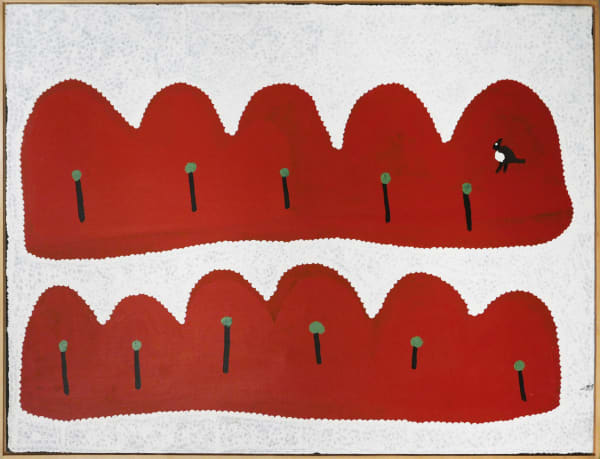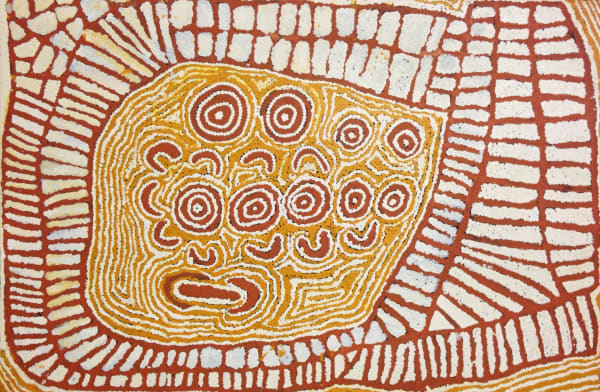The Artist's Eye: An Exhibition of Aboriginal Art curated by David Bromley: Group Show
Over the last 30 years the contemporary art scene in Australia has been dominated by the emergence and extraordinary growth of the Aboriginal art movement. A whole new artistic tradition - albeit one with its roots reaching back many millennia - has been established. It has achieved an international profile, while in Australia it has come to dominate the critical debate, the exhibition schedules and the market place.
This phenomenon has been both a challenge and an inspiration for Australia’s white artists. They have had to confront the novel forms and fashions of indigenous art. And many have responded with real power and originality. It is surely no coincidence that the work of the rising generation of white Australians artists displays a new and exceptional spirit. Aboriginal art has energised the culture of the continent - and of the world.
David Bromley is one of Australia’s brightest young painters. He has exhibited across Australia as well as in London and New York. Although Bromley is a white artist working in the figurative tradition, he has a profound knowledge - and love - of Aboriginal painting. Its influence upon his own work is never obvious or direct, but it is real.
This exhibition gives a sense of that vitality of engagement.
This exhibition is the first time a white Australian artists has selected and introduced a body of work by his Aboriginal contemporaries. It is the response of one artistic sensibility to some of the most exciting painting being produced in the world today. It has been a pleasure and a privilege to work with David Bromley and his partner Tori Dixon-Whittle, whose commitment to this project has been inspiring.
Rebecca Hossack
'Recently I was discussing picture collecting with Charles Blackman, one of Australia’s leading painters (and, without a doubt, a national treasure). He gave me perhaps the best insight into how to choose a painting. It was simple. When you see a piece of art and are drawn to it for whatever reason, you engage with it. But it is only if the piece of art engages you back that you should try and get it. In such instances a connection has been made.
That is the relationship I have with the works in this show. Most of them come from my personal collection built up over the past ten years. The others I have selected as if I were choosing them for myself. With all of them I have that feeling of connection.
The exact details and mechanics of this relationship I try not to examine too closely. I feel it strongly and that is enough. I love these pictures and they speak to me.
Nevertheless these are some specific things about the great appeal - to me - of Aboriginal art that I do recognise. There is an unselfconscious directness and emotionally-charged energy to many of the paintings, so unlike the self-referential concerns of much contemporary, ‘Western’ art. The images are full of meaning. And even if that meaning for us is often obscure, its very presence carries a moral force and authority. More than any of this, I find the pictures beautiful - in their uninhibited sense of rhythm, in their use of colour, in their strength of design. The very ‘differentness’ of Aboriginal art from my own painting is liberating; it provides both a welcome relief from my own set of realities, and a challenge to see the world in a different way.'
David Bromley
-
 Kayi Kayi Nampitjimpa, Desert Raisin Dreaming, 2001
Kayi Kayi Nampitjimpa, Desert Raisin Dreaming, 2001 -
 Michael Nelson Jagamara
Michael Nelson Jagamara -
 Tatali Napurrula, Desert Raisin Dreaming, 2001
Tatali Napurrula, Desert Raisin Dreaming, 2001 -
 Warlimpirrnga Tjapaltjarri, Tingari Cycle , 2001
Warlimpirrnga Tjapaltjarri, Tingari Cycle , 2001 -
 Kayi Kayi Nampitjimpa, Tingari Cycle , 2001
Kayi Kayi Nampitjimpa, Tingari Cycle , 2001 -
 Pantjiya Nungurrayi, Desert Raisin Dreaming, 2001
Pantjiya Nungurrayi, Desert Raisin Dreaming, 2001 -
 Linda Syddick Napaltjarri, E.T with a Broken Arm After Drinking Two Cans of Beer, 2000
Linda Syddick Napaltjarri, E.T with a Broken Arm After Drinking Two Cans of Beer, 2000 -
 Ronnie Tjampitjimpa, Tingari Cycle , 200
Ronnie Tjampitjimpa, Tingari Cycle , 200 -
 Yuyuya Nampitjinpa, Women's Ceremony, 2001
Yuyuya Nampitjinpa, Women's Ceremony, 2001 -
 Willy Tjungurrayi, Tingari Cycle , 1998
Willy Tjungurrayi, Tingari Cycle , 1998 -
 Mitjili Naparrula, Kulata Tjukurrpa Tree Dreaming, 2001
Mitjili Naparrula, Kulata Tjukurrpa Tree Dreaming, 2001 -
 Walala Tjapaltjarri, Tingari Cycle, 2002
Walala Tjapaltjarri, Tingari Cycle, 2002 -
 Ningura Napurrula, Desert Raisin Dreaming, 2001
Ningura Napurrula, Desert Raisin Dreaming, 2001 -
 Nanyuma Napangati, Women's Dreaming, 2001
Nanyuma Napangati, Women's Dreaming, 2001 -
 Nanyuma Napangati, Women's Dreaming , 2001
Nanyuma Napangati, Women's Dreaming , 2001 -
 Long Tom Tjapanangka, Puli Tjuti & Willy Wag Tail Dreaming , 1998
Long Tom Tjapanangka, Puli Tjuti & Willy Wag Tail Dreaming , 1998 -
 Nanyuma Napangati, Tjintulakan Punya, 1999
Nanyuma Napangati, Tjintulakan Punya, 1999

















